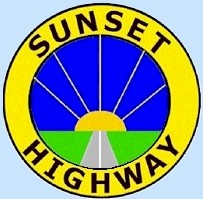
The Historic Sunset Highway
in Washington
Coulee City to Wilber

The Historic Sunset Highway
in Washington
Coulee City to Wilber
Description of the Route
The road to Hartline is flat with nothing much but wheat fields and scrub. The 1915 route from Coulee City heads due east on Rd 36 NE for about five miles.
At N Rd NE you turn left and continue north three miles to Rd 39 NE. Then right for four miles to R Rd NE. In 1918 the route was changed and bypassed N Rd NE and Rd 39 NE. The eliminated a couple of turns so it was nine miles east and then five miles north to connect with the current Hwy 2 at the southern edge of Hartline.
In the 1933 the route was changed again and Coulee City was bypassed and the road took a diagonal route NE along the railroad to Hartline. When the dam was was completed in 1949 the road was flooded by Banks Lake and the highway was rerouted across the top of the dam.
There was a proposal to route the road from a point just above Rd 37 NE Before Hwy 2 turned north. The hwy was proposed to connect to Rd 39 NE. This was never constructed.
The 1933 alignment continued NE on Fordair Rd. and then follows the railroad seven and a half miles to 41st Rd NE where it veers right passing along the southern edge of Hartline. The highway never entered town.
From Hartline the original road follows in the path of the current hwy for six miles to X Rd NE. Then it was north to Maxwell Rd. The highway then follows Maxwell Rd for almost 2.5 miles into Almira. This section was improved in 1918 and the corners were rounded.
Almira is a small farming community. The town got its name from the first settler in the 1880’s Charles C. Davis who purchased land and erected a small store to serve the few settlers living in the area. He named the place Almira after his wife’s given name. His farm had previously been called "Davisine".
Leaving Almira the original road followed Main St. to N 3rd St turned left and continued north over the RR tracks to Raber Rd. Here it was east for almost a mile and then over the tracks again.
A 100 years ago the road forked and the traveler needed to take the left fork and follow NE along the Railroad tracks to Corbett Draw Rd.
Originally the road crossed the tracks twice at Corbitt Draw. These 2 crossings were bypassed about 1918 as the road stayed on the south side the tracks instead.
You then continue east over Hwy 2 to connect with Andersen Rd E. At Corbett Draw Rd you have to turn right and head south on this dirt road to Hwy 2 as the old road on the east side of Corbett Draw Rd is impassable.
Back on US 2 head east and turn right onto Bruce Rd as this connects to Anderson Rd. E. In two and a half miles you reach Govan.
Not much remains of Govan except for some old houses a grain elevator and the old schoolhouse. The abandoned schoolhouse is a great place for some photos.
After Govan you travel a mile up Govan Rd N across US 2 to Bandy Rd. Take the right and in about a mile Bandy Rd connects back to US 2 and then continue east toward Wilbur. In about a mile the hwy continued east on Wilber Airport Rd while US 2 veers to the NE.
Wilbur Airport Rd does not go through into town anymore because of the airport. In 1918 the highway was realignment about 3/4ths of a mile down Wilber Airport Rd.
This alignment veers to the NE and curved around the railroad and connect with Golf Rd. You can’t follow this old alignment anymore until you get to Golf Rd which then enters town.